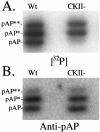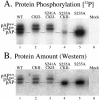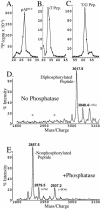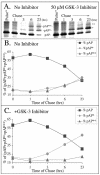Assembly protein precursor (pUL80.5 homolog) of simian cytomegalovirus is phosphorylated at a glycogen synthase kinase 3 site and its downstream "priming" site: phosphorylation affects interactions of protein with itself and with major capsid protein
- PMID: 15564461
- PMCID: PMC533919
- DOI: 10.1128/JVI.78.24.13501-13511.2004
Assembly protein precursor (pUL80.5 homolog) of simian cytomegalovirus is phosphorylated at a glycogen synthase kinase 3 site and its downstream "priming" site: phosphorylation affects interactions of protein with itself and with major capsid protein
Abstract
Capsid assembly among the herpes-group viruses is coordinated by two related scaffolding proteins. In cytomegalovirus (CMV), the main scaffolding constituent is called the assembly protein precursor (pAP). Like its homologs in other herpesviruses, pAP is modified by proteolytic cleavage and phosphorylation. Cleavage is essential for capsid maturation and production of infectious virus, but the role of phosphorylation is undetermined. As a first step in evaluating the significance of this modification, we have identified the specific sites of phosphorylation in the simian CMV pAP. Two were established previously to be adjacent serines (Ser156 and Ser157) in a casein kinase II consensus sequence. The remaining two, identified here as Thr231 and Ser235, are within consensus sequences for glycogen synthase kinase 3 (GSK-3) and mitogen-activated protein kinase, respectively. Consistent with Thr231 being a GSK-3 substrate, its phosphorylation required a downstream "priming" phosphate (i.e., Ser235) and was reduced by a GSK-3-specific inhibitor. Phosphorylation of Ser235 converts pAP to an electrophoretically slower-mobility isoform, pAP*; subsequent phosphorylation of pAP* at Thr231 converts pAP* to a still-slower isoform, pAP**. The mobility shift to pAP* was mimicked by substituting an acidic amino acid for either Thr231 or Ser235, but the shift to pAP** required that both positions be phosphorylated. Glu did not substitute for pSer235 in promoting phosphorylation of Thr231. We suggest that phosphorylation of Thr231 and Ser235 causes charge-driven conformational changes in pAP, and we demonstrate that preventing these modifications alters interactions of pAP with itself and with major capsid protein, suggesting a functional significance.
Figures













Similar articles
-
Phosphorylation of simian cytomegalovirus assembly protein precursor (pAPNG.5) and proteinase precursor (pAPNG1): multiple attachment sites identified, including two adjacent serines in a casein kinase II consensus sequence.J Virol. 1999 Nov;73(11):9053-62. doi: 10.1128/JVI.73.11.9053-9062.1999. J Virol. 1999. PMID: 10516011 Free PMC article.
-
Human cytomegalovirus capsid assembly protein precursor (pUL80.5) interacts with itself and with the major capsid protein (pUL86) through two different domains.J Virol. 1997 Jan;71(1):179-90. doi: 10.1128/JVI.71.1.179-190.1997. J Virol. 1997. PMID: 8985337 Free PMC article.
-
Virus-specific interaction between the human cytomegalovirus major capsid protein and the C terminus of the assembly protein precursor.J Virol. 1996 Nov;70(11):8081-8. doi: 10.1128/JVI.70.11.8081-8088.1996. J Virol. 1996. PMID: 8892933 Free PMC article.
-
Cytomegalovirus assembly protein precursor and proteinase precursor contain two nuclear localization signals that mediate their own nuclear translocation and that of the major capsid protein.J Virol. 1998 Oct;72(10):7722-32. doi: 10.1128/JVI.72.10.7722-7732.1998. J Virol. 1998. PMID: 9733808 Free PMC article.
-
Nuclear localization sequences in cytomegalovirus capsid assembly proteins (UL80 proteins) are required for virus production: inactivating NLS1, NLS2, or both affects replication to strikingly different extents.J Virol. 2008 Jun;82(11):5381-9. doi: 10.1128/JVI.02697-07. Epub 2008 Mar 19. J Virol. 2008. PMID: 18353959 Free PMC article.
Cited by
-
Small capsid protein pORF65 is essential for assembly of Kaposi's sarcoma-associated herpesvirus capsids.J Virol. 2008 Jul;82(14):7201-11. doi: 10.1128/JVI.00423-08. Epub 2008 May 7. J Virol. 2008. PMID: 18463150 Free PMC article.
-
PPARgamma agonists rescue increased phosphorylation of FGF14 at S226 in the Tg2576 mouse model of Alzheimer's disease.Exp Neurol. 2017 Sep;295:1-17. doi: 10.1016/j.expneurol.2017.05.005. Epub 2017 May 15. Exp Neurol. 2017. PMID: 28522250 Free PMC article.
-
Regulation of Wnt/β-catenin signaling by herpesviruses.World J Virol. 2016 Nov 12;5(4):144-154. doi: 10.5501/wjv.v5.i4.144. World J Virol. 2016. PMID: 27878101 Free PMC article. Review.
-
Self-assembly of Epstein-Barr virus capsids.J Virol. 2009 Apr;83(8):3877-90. doi: 10.1128/JVI.01733-08. Epub 2009 Jan 21. J Virol. 2009. PMID: 19158247 Free PMC article.
-
Barrier-to-autointegration factor phosphorylation on Ser-4 regulates emerin binding to lamin A in vitro and emerin localization in vivo.Mol Biol Cell. 2006 Mar;17(3):1154-63. doi: 10.1091/mbc.e05-04-0356. Epub 2005 Dec 21. Mol Biol Cell. 2006. PMID: 16371512 Free PMC article.
References
-
- Ausubel, F. M., R. Brent, R. E. Kingston, D. D. Moore, J. G. Seidman, J. A. Smith, and K. Struhl. 1990. Current protocols in molecular biology. John Wiley and Sons, New York, N.Y.
-
- Coghlan, M. P., A. A. Culbert, D. A. Cross, S. L. Corcoran, J. W. Yates, N. J. Pearce, O. L. Rausch, G. J. Murphy, P. S. Carter, L. R. Cox, D. Mills, M. J. Brown, D. Haigh, R. W. Ward, D. G. Smith, K. J. Murray, A. D. Reith, and J. C. Holder. 2000. Selective small molecule inhibitors of glycogen synthase kinase-3 modulate glycogen metabolism and gene transcription. Chem. Biol. 7:793-803. - PubMed
-
- Desai, P., and S. Person. 1996. Molecular interactions between the HSV-1 capsid proteins as measured by the yeast two-hybrid system. Virology 220:516-521. - PubMed
Publication types
MeSH terms
Substances
Grants and funding
LinkOut - more resources
Full Text Sources
Other Literature Sources
Molecular Biology Databases
Research Materials

